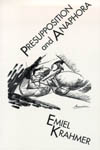In this book, two related phenomena are studied: presupposition and anaphora. Dynamic semantics is by now widely accepted as a first-rate foundation for such an exercise and it forms the backbone of most of the work in this book.
A recurring additional theme of the present book is the usefulness of techniques from partial logic in the treatment of both phenomena.
Rather than adding completely new semantic theories to the present gamut of theories, the author discusses a number of existing approaches which aim at accounting for the behavior of presuppositions and/or anaphors, makes improvements where necessary, and compares the results.
Presupposition and Anaphora starts with an introduction to a number of dynamic semantic theories and their correlations, paying special attention to the treatment of disjunctions and negations. Subsequently, presuppositions are studied in the context of partial logics, Montague Grammar and dynamic semantics. Finally, the author zooms in on one type of presuppositions, namely those triggered by definite noun phrases.
Emiel Krahmer is a researcher at the Institute for Perception Research (IPO) in the Center for Research on User-System Interaction, at Eindhoven University of Technology.
From the review in Linguistics, Volume 37-2001
“This book shows great erudition and competence in discussing rival theories. It also places the study of presupposition on a better footing by considering the analogies between anaphora resolution and presupposition resolution. I personally find this book very instructive and well-constructed, one of those books which can be read with great interest in so far as it raises important questions….
I am persuaded that Krahmer's book represents a good monograph on the issue of presupposition and anaphora, one that does not hesitate to delve into problems in an attempt to resolve them. I believe that this is an important chapter of linguistics and that many avenues of research can be opened up by it.”–Alessandro Capone, University of Messina
- Acknowledgements
- 1 Introduction
- 1.1 Background
- 1.1.1 Anaphora
- 1.1.2 Presupposition
- 1.1.3 Anaphora and Presupposition
- 1.2 About this Book
- 1.2.1 Anaphora
- 1.2.2 Presupposition
- 1.2.3 Anaphora and Presupposition
- 1.3 Overview
- 2 Anaphora and Discourse Semantics
- 2.1 Introduction
- 2.2 Representational Theories of Discourse
- 2.2.1 File Change Semantics
- 2.2.2 Discourse Representation Theory
- 2.2.3 From FCS to DRT
- 2.2.4 DRT Interpretation Using Total Assignments
- 2.2.3 From DRT to Predicate Logic
- 2.3 Non-representational
- 2.3.1 Quantificational Dynamic Logic
- 2.3.2 Dynamic Predicat Logic
- 2.3.3 A Dynamic Version of Montague Grammar
- 2.4 Discussion: The Quest for the Theory of Discourse
- 2.4.1 The Dynamic Cube
- 2.4.2 Extensions and Modifications
- 3 Negation and Dijunction in DRT
- 3.1 Introduction
- 3.2 Two Problems for DRT and a Reduction
- 3.2.1 The Double Negation Problem
- 3.2.2 The Disjunction Problem
- 3.3 Double Negation DRT
- 3.4 Applications
- 3.5 The Relation with Standard DRT
- 3.6 Discussion: Uniqueness, Inference
- 4 Presupposition and Partiality
- 4.1 Introduction
- 4.2 Partial Predicate Logic
- 4.2.1 Strong Kleene PPL
- 4.2.2 Middle Kleene PPL
- 4.2.3 Weak Kleene PPL
- 4.3 Presupposition and PPL
- 4.3.1 Determining Presuppositon
- 4.3.2 Predictions
- 4.4 Flexibility: The Floating A Theory
- 4.5 Discussion
- 4.5.1 Karttunen and Peters Revisited
- 4.5.2 A Note on the Logic of Conventional
- Appendix
- 5 Presuppositon and Montague Grammar
- 5.1 Introduction
- 5.2 Partial Type Theory
- 5.3 Presuppositional Montague Grammar
- 5.4 Discussion: Extending the Fragment
- 5.4.1 Additional Presuppositions
- 5.4.2 Note
- 5.4.3 Dynamifying Presuppositional Montague Grammar
- 5.4.4 Implicatures and Dynamics
- Appendix: The Fragement
- 6 Presupposition and Discourse Semantics
- 6.1 Introduction
- 6.2 Presuppositions-as-Anaphoras
- 6.2.1 Resolving Presuppositions
- 6.2.2 What is Presuppositional DRS?
- 6.2.3 Procedural vs. Declarative
- 6.2.4 Accommodating Failing Presuppositions
- 6.2.5 Disjunctions
- 6.2.6 Presupposition-Quantification Interaction
- 6.3 Presuppositional DRT
- 6.4 Applications
- 6.5 Determining Semantic Presuppositons
- 6.6 Again: Presupposition
- 6.7 Discussion: Comparing the Two Approaches
- 6.7.1 Does Binding Preserve Meaning?
- 6.7.2 Does Accommodation Preserve Meaning?
- 6.7.3 An Alternative Interpretation
- 6.2.4 Presupposition Prejection as Proof Construction
- Appendix
- 7 Presupposition and Determinedness
- 7.1 Introduction
- 7.2 Is Determinedness Uniqueness?
- 7.2.1 Restricting the Uniqueness Prediction
- 7.3 Is Determinedness Anaphoricity?
- 7.3.1 Accommodating Missing Antecedents
- 7.4 Determinedness is Familiarity
- 7.5 Determinedness is Salience
- 7.6 Discussion: Extending the Analysis
- 7.6.1 Dependencies and Non-identity Anaphora
- 7.6.2 Definites and Salience
- 7.6.3 Surroundings: The Dynamics of Pointing
- 8 Concluding Remarks
- 8.1 Summary
- 8.1.1 Anaphora
- 8.1.2 Presupposition
- 8.1.3 Anaphora and Presupposition
- 8.2 Discussion: Rounding Off
- Bibliography
- Subject Index
- Name Index
9/1/98


